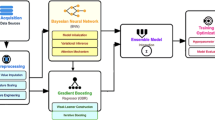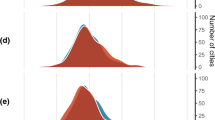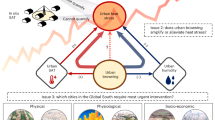Abstract
Background
Lower socioeconomic (SES) communities are more likely to be situated in urban heat islands and have higher heat exposures than their higher SES counterparts, and this inequality is expected to intensify due to climate change.
Objectives
To examine the relationship between surface temperatures and SES in New York City (NYC) by employing a novel analytical approach. Through incorporating modifiable features, this study aims to identify potential locations where mitigation interventions can be implemented to reduce heat disparities associated with SES.
Methods
Using the 2013–2017 American Community Survey, U.S Landsat-8 Analysis Ready Data surface temperatures (measured on 8/12/2016), and the NYC Land Cover Dataset at the census tract level (2098 tracts), this study examines the association between two components of tract-level SES (percentage of individuals living below the poverty line and the percentage of individuals without a high school degree) and summer day surface temperature in NYC. First, we examine this association with an unrestricted NYC linear regression, examining the city-wide association between the two SES facets and summer surface temperature, with additional models adjusting for altitude, shoreline, and nature-cover. Then, we assess geographic effect measure modification by employing the same models to three supplemental regression model strategies (borough-restricted and community district-restricted linear regressions, and geographically weighted regression (GWR)) that examined associations within smaller intra-city areas.
Results
All regression strategies identified areas where lower neighborhood SES composition is associated with higher summer day surface temperatures. The unrestricted NYC regressions revealed widespread disparities, while the borough-restricted and community district-restricted regressions identified specific political boundaries within which these disparities existed. The GWR, addressing spatial autocorrelation, identified significant socioeconomic heat disparities in locations such as northwest Bronx, central Brooklyn, and uptown Manhattan. These findings underscore the need for targeted policies and community interventions, including equitable urban planning and cooling strategies, to mitigate heat exposure in vulnerable neighborhoods.
Impact statement
-
This study redefines previous research on urban socioeconomic disparities in heat exposure by investigating both modifiable (nature cover) and non-modifiable (altitude and shoreline) built environment factors affecting local temperatures at the census tract level in New York City. Through a novel analytical approach, the research aims to highlight intervention opportunities to mitigate heat disparities related to socioeconomic status. By examining the association between surface temperatures and socioeconomic status, as well as investigating different geographic and governmental scales, this study offers actionable insights for policymakers and community members to address heat exposure inequalities effectively across different administrative boundaries. The objective is to pinpoint potential sites for reducing socioeconomic heat exposure disparities at various geographic and political levels.
This is a preview of subscription content, access via your institution
Access options
Subscribe to this journal
Receive 6 print issues and online access
$259.00 per year
only $43.17 per issue
Buy this article
- Purchase on SpringerLink
- Instant access to full article PDF
Prices may be subject to local taxes which are calculated during checkout


Similar content being viewed by others
Data availability
Data will be made available on request.
References
Galobardes B, Shaw M, Lawlor DA, Lynch JW, Smith GD. Indicators of socioeconomic position (part 1). J Epidemiol Commun Health. 2006;60:7–12.
Williams DR, Mohammed SA, Leavell J, Collins C. Race, socioeconomic status, and health: complexities, ongoing challenges, and research opportunities. Ann N Y Acad Sci. 2010;1186:69–101.
Phelan JC, Link BG, Tehranifar P. Social conditions as fundamental causes of health inequalities: theory, evidence, and policy implications. J Health Soc Behav. 2010;51:S28–S40.
Lovasi GS, Hutson MA, Guerra M, Neckerman KM. Built environments and obesity in disadvantaged populations. Epidemiol Rev. 2009;31:7–20.
Pearce J, Witten K, Hiscock R, Blakely T. Are socially disadvantaged neighbourhoods deprived of health-related community resources? Int J Epidemiol. 2007;36:348–55.
Clark LP, Millet DB, Marshall JD. National patterns in environmental injustice and inequality: outdoor NO2 air pollution in the United States. PLoS ONE. 2014;9:e94431.
Sprague NL, Rundle AG, Ekenga CC. The COVID-19 pandemic as a threat multiplier for childhood health disparities: evidence from St. Louis, MO. J Urban Health. 2022;99:208–17.
Dodson JC, Dérer P, Cafaro P, Götmark F. Population growth and climate change: addressing the overlooked threat multiplier. Sci Total Environ. 2020;748:141346.
Below A. The existential threat multiplier. Understanding New Security Threats. 2019.
Sprague NL, Uong SP, Jacobowitz AL, Packard SE, Quinn JW, Keyes KM, et al. Examining racial and ethnic heat exposure disparities in New York City (NYC) across different spatial and political scales through geographic effect measure modification. Environ Res. 2024;250:118521.
Gasper R, Blohm A, Ruth M. Social and economic impacts of climate change on the urban environment. Curr Opin Environ Sustain. 2011;3:150–7.
Hsu A, Sheriff G, Chakraborty T, Manya D. Disproportionate exposure to urban heat island intensity across major US cities. Nat Commun. 2021;12:2721.
Harlan SL, Declet-Barreto JH, Stefanov WL, Petitti DB. Neighborhood effects on heat deaths: social and environmental predictors of vulnerability in Maricopa County, Arizona. Environ Health Persp. 2013;121:197–204.
Kjellstrom T, Holmer I, Lemke B. Workplace heat stress, health and productivity–an increasing challenge for low and middle-income countries during climate change. Glob Health Act. 2009;2:2047.
Zografos C, Anguelovski I, Grigorova M. When exposure to climate change is not enough: Exploring heatwave adaptive capacity of a multi-ethnic, low-income urban community in Australia. Urban Clim. 2016;17:248–65.
Shaker RR, Altman Y, Deng C, Vaz E, Forsythe KW. Investigating urban heat island through spatial analysis of New York City streetscapes. J Clean Prod. 2019;233:972–92.
Gaffin SR, Rosenzweig C, Khanbilvardi R, Parshall L, Mahani S, Glickman H, et al. Variations in New York City’s urban heat island strength over time and space. Theor Appl Climatol. 2008;94:1–11.
Rosenzweig C, Solecki WD, Parshall L, Lynn B, Cox J, Goldberg R, et al. Mitigating New York City’s Heat Island: integrating stakeholder perspectives and scientific evaluation. Bull Am Meteorol Soc. 2009;90:1297–312.
Corburn J. Cities, climate change and urban heat island mitigation: localising global environmental science. Urban Stud. 2009;46:413–27.
Wang J, McPhearson T, Zhou W, Cook EM, Herreros-Cantis P, Liu J. Comparing relationships between urban heat exposure, ecological structure, and socio-economic patterns in Beijing and New York City. Landsc Urban Plan. 2023;235:104750.
Ilbeigi M, Jagupilla SCK. An empirical analysis of association between socioeconomic factors and communities’ exposure to natural hazards. Sustainability 2020;12:6342.
Rastogi D, Christian J, Tuccillo J, Christian B, Kapadia AJ, Hanson HA. Exploring the spatial patterning of sociodemographic disparities in extreme heat exposure at multiple scales across the conterminous United States. Geohealth. 2023;7:e2023GH000864.
Renteria R, Grineski S, Collins T, Flores A, Trego S. Social disparities in neighborhood heat in the Northeast United States. Environ Res. 2022;203:111805.
Lopez PM, Subramanian SV, Schooling CM. Effect measure modification conceptualized using selection diagrams as mediation by mechanisms of varying population-level relevance. J Clin Epidemiol. 2019;113:123–8.
Stürmer T, Rothman KJ, Glynn RJ. Insights into different results from different causal contrasts in the presence of effect‐measure modification. Pharmacoepidemiol Drug Saf. 2006;15:698–709.
Linn S, Levi L, Grunau PD, Zaidise I, Zarka S. Effect measure modification and confounding of severe head injury mortality by age and multiple organ injury severity. Ann Epidemiol. 2007;17:142–7.
Buckley JP, Doherty BT, Keil AP, Engel SM. Statistical approaches for estimating sex-specific effects in endocrine disruptors research. Environ Health Persp. 2017;125:067013.
Kubo A, Cook MB, Shaheen NJ, Vaughan TL, Whiteman DC, Murray L, et al. Sex-specific associations between body mass index, waist circumference and the risk of Barrett’s oesophagus: a pooled analysis from the international BEACON consortium. Gut 2013;62:1684–91.
2017 TIGER/Line Shapefiles (machinereadable data files). US Census Beauru 2017.
Duncan GJ, Magnuson K. Socioeconomic status and cognitive functioning: moving from correlation to causation. Wiley Interdiscip Rev Cogn Sci. 2012;3:377–86.
Evans GW, Marcynyszyn LA. Environmental justice, cumulative environmental risk, and health among low-and middle-income children in upstate New York. Am J Public Health. 2004;94:1942–4.
Cutler DM, Lleras-Muney A. Understanding differences in health behaviors by education. J Health Econ. 2010;29:1–28.
Sprague NL, Branas CC, Rundle AG, Factor-Litvak P. Educational outcomes are an underused metric for child and life course health. Am J Public Health. 2024;114:864–9.
Krieger N, Chen JT, Waterman PD, Rehkopf DH, Subramanian SV. Painting a truer picture of US socioeconomic and racial/ethnic health inequalities: the public health disparities geocoding project. Am J Public Health. 2005;95:312–23.
Krieger N, Chen JT, Waterman PD, Soobader M-J, Subramanian SV, Carson R. Geocoding and monitoring of US socioeconomic Inequalities in mortality and cancer incidence: does the choice of area-based measure and geographic level matter?: The public health disparities geocoding project. Am J Epidemiol. 2002;156:471–82.
Krieger N, Waterman PD, Chen JT, Soobader MJ, Subramanian SV. Monitoring socioeconomic inequalities in sexually transmitted infections, tuberculosis, and violence: geocoding and choice of area-based socioeconomic measures–the public health disparities geocoding project (US). Public Health Rep. 2003;118:240–60.
Krieger N, Chen JT, Waterman PD, Soobader MJ, Subramanian SV, Carson R. Choosing area based socioeconomic measures to monitor social inequalities in low birth weight and childhood lead poisoning: The Public Health Disparities Geocoding Project (US). J Epidemiol Community Health. 2003;57:186–99.
Bureau USC. American Community Survey (ACS). United States Census Bureau 2019.
Dwyer JL, Roy DP, Sauer B, Jenkerson CB, Zhang HK, Lymburner L. Analysis ready data: enabling analysis of the Landsat archive. Remote Sens. 2018;10:1363.
Tzavali A, Paravantis JP, Mihalakakou G, Fotiadi A, Stigka E. Urban heat island intensity: a literature review. Fresen Environ Bull. 2015;24:4537–54.
Laaidi K, Zeghnoun A, Dousset B, Bretin P, Vandentorren S, Giraudet E, et al. The impact of heat islands on mortality in Paris during the August 2003 heat wave. Environ Health Persp. 2012;120:254–9.
Ho HC, Knudby A, Sirovyak P, Xu Y, Hodul M, Henderson SB. Mapping maximum urban air temperature on hot summer days. Remote Sens Environ. 2014;154:38–45.
Parker DE. Urban heat island effects on estimates of observed climate change. WIREs Clim Change. 2010;1:123–33.
Hough I, Just AC, Zhou B, Dorman M, Lepeule J, Kloog I. A multi-resolution air temperature model for France from MODIS and landsat thermal data. Environ Res. 2020;183:109244.
Keramitsoglou I, Daglis IA, Amiridis V, Chrysoulakis N, Ceriola G, Manunta P, et al. Evaluation of satellite-derived products for the characterization of the urban thermal environment. J Appl Remote Sens. 2012;6:061704.
Shi L, Liu P, Kloog I, Lee M, Kosheleva A, Schwartz J. Estimating daily air temperature across the Southeastern United States using high-resolution satellite data: a statistical modeling study. Environ Res. 2016;146:51–8.
Vancutsem C, Ceccato P, Dinku T, Connor SJ. Evaluation of MODIS land surface temperature data to estimate air temperature in different ecosystems over Africa. Remote Sens Environ. 2010;114:449–65.
Kamptner E. NYC Planimetrics Database. In: Telecommunications NDoITa, editor. 2016.
Chakraborty T, Hsu A, Manya D, Sheriff G. A spatially explicit surface urban heat island database for the United States: Characterization, uncertainties, and possible applications. ISPRS J Photogramm Remote Sens. 2020;168:74–88.
Hoffman JS, Shandas V, Pendleton N. The effects of historical housing policies on resident exposure to intra-urban heat: a study of 108 US urban areas. Climate. 2020;8:12.
Wilson B. Urban heat management and the legacy of redlining. J Am Plan Assoc. 2020;86:443–57.
MacFaden SW, O’Neil-Dunne JP, Royar AR, Lu JW, Rundle AG. High-resolution tree canopy mapping for New York City using LIDAR and object-based image analysis. J Appl Remote Sens. 2012;6:063567.
Tran F, Morrison C. Income inequality and suicide in the United States: A spatial analysis of 1684 US counties using geographically weighted regression. Spat Spatio-temporal Epidemiol. 2020;34:100359.
Lotfata A, Grekousis G, Wang R. Using geographical random forest models to explore spatial patterns in the neighborhood determinants of hypertension prevalence across Chicago, Illinois, USA. Environ Plan B Urban Anal City Sci. 2023;50:2376–93.
Maroko AR, Maantay JA, Sohler NL, Grady KL, Arno PS. The complexities of measuring access to parks and physical activity sites in New York City: a quantitative and qualitative approach. Int J Health Geogr. 2009;8:1–23.
Fotheringham AS, Crespo R, Yao J. Geographical and temporal weighted regression (GTWR). Geogr Anal. 2015;47:431–52.
Getis A, Ord JK. The analysis of spatial association by use of distance statistics. Geogr Anal. 1992;24:189–206.
Fu W, Zhao K, Zhang C, Tunney H, Using Moran’s I. and geostatistics to identify spatial patterns of soil nutrients in two different long-term phosphorus-application plots. J Plant Nutr Soil Sci. 2011;174:785–98.
Chakraborty T, Hsu A, Manya D, Sheriff G. Disproportionately higher exposure to urban heat in lower-income neighborhoods: a multi-city perspective. Environ Res Lett. 2019;14:105003.
Gronlund CJ. Racial and socioeconomic disparities in heat-related health effects and their mechanisms: a review. Curr Epidemiol Rep. 2014;1:165–73.
Islami F, Kahn AR, Bickell NA, Schymura MJ, Boffetta P. Disentangling the effects of race/ethnicity and socioeconomic status of neighborhood in cancer stage distribution in New York City. Cancer Causes Control. 2013;24:1069–78.
Richards DR, Thompson BS. Urban ecosystems: a new frontier for payments for ecosystem services. People Nat. 2019;1:249–61.
Flocks J, Escobedo F, Wade J, Varela S, Wald C. Environmental justice implications of urban tree cover in Miami-Dade County, Florida. Environ Justice 2011;4:125–34.
Mason E, Montalto FA. The overlooked role of New York City urban yards in mitigating and adapting to climate change. Local Environ. 2015;20:1412–27.
Susca T, Gaffin SR, Dell’Osso GR. Positive effects of vegetation: Urban heat island and green roofs. Environ Pollut. 2011;159:2119–26.
Smith JP, Li X, Turner BL II. Lots for greening: Identification of metropolitan vacant land and its potential use for cooling and agriculture in Phoenix, AZ, USA. Appl Geogr. 2017;85:139–51.
De Munck C, Lemonsu A, Masson V, Le Bras J, Bonhomme M. Evaluating the impacts of greening scenarios on thermal comfort and energy and water consumptions for adapting Paris city to climate change. Urban Clim. 2018;23:260–86.
Li D, Newman GD, Wilson B, Zhang Y, Brown RD. Modeling the relationships between historical redlining, urban heat, and heat-related emergency department visits: an examination of 11 Texas cities. Env Plan B Urban Anal City Sci 2022;49:933–52.
Sprague NL, Gobaud AN, Mehranbod CA, Morrison CN, Branas CC, Jacobowitz AL. Overflowing disparities: examining the availability of litter bins in New York City. Int J Environ Res Public Health. 2022;19:5107.
Acknowledgements
Thank you to Dr. Christopher N Morrison for his assistance in developing the methodology for data analysis.
Funding
This project was supported by the National Institute of Mental Health (Grant number: R01MH128734).
Author information
Authors and Affiliations
Contributions
Nadav L. Sprague: Writing – original draft, Writing – review & editing, Visualization, Validation, Software, Project administration, Methodology, Investigation, Formal analysis, Data curation, Conceptualization. Stephen P. Uong: Writing – review & editing, Visualization, Validation, Formal analysis. Nora C Kelsall: Writing – review & editing. Ahuva L. Jacobowitz: Methodology, Investigation, Conceptualization. James W. Quinn: Supervision, Software, Project administration, Investigation, Formal analysis, Data curation. Katherine M. Keyes: Writing – review & editing, Supervision, Resources, Project administration, Methodology, Investigation, Funding acquisition, Conceptualization. Andrew G. Rundle: Writing – review & editing, Visualization, Validation, Supervision, Software, Resources, Project administration, Methodology, Investigation, Funding acquisition, Formal analysis, Data curation, Conceptualization.
Corresponding author
Ethics declarations
Competing interests
The authors declare that they have no known conflict of interests (such as competing financial interests or personal relationships) that could have appeared to influence the work reported in this paper.
Ethical statement
Institutional Review Board (IRB) approval was not necessary for this study as it exclusively relied on publicly available census data and other geospatial information that does not involve personal or sensitive human-centric data.
Additional information
Publisher’s note Springer Nature remains neutral with regard to jurisdictional claims in published maps and institutional affiliations.
Supplementary information
Rights and permissions
Springer Nature or its licensor (e.g. a society or other partner) holds exclusive rights to this article under a publishing agreement with the author(s) or other rightsholder(s); author self-archiving of the accepted manuscript version of this article is solely governed by the terms of such publishing agreement and applicable law.
About this article
Cite this article
Sprague, N.L., Uong, S.P., Kelsall, N.C. et al. Using geographic effect measure modification to examine socioeconomic-related surface temperature disparities in New York City. J Expo Sci Environ Epidemiol 35, 792–801 (2025). https://doi.org/10.1038/s41370-024-00714-6
Received:
Revised:
Accepted:
Published:
Issue date:
DOI: https://doi.org/10.1038/s41370-024-00714-6



